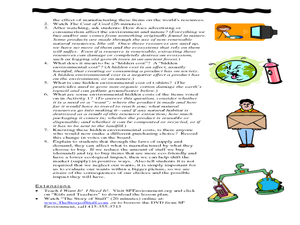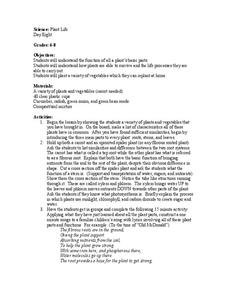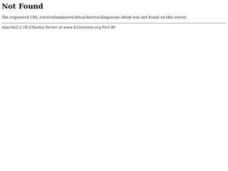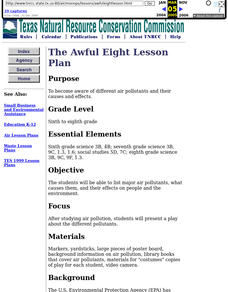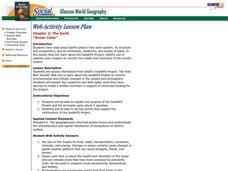Curated OER
Cloze Passage: Destruction of the Earth
In this destruction of the earth cloze procedure instructional activity, students fill in the 12 missing words in the passage to help identify their reading level.
Curated OER
Ocean Currents
Students examine ocean currents. In this investigative lesson, students examine ocean currents and the relationship between the ocean, our atmosphere, and the weather. They will create a model of an ocean current.
Curated OER
The Social and Economic Impact of Wildlife and Natural Resource Management
Students develop an understanding of environmental laws and regulations. In this research lesson, students utilize information that involves controversial issues of wildlife and society.
Curated OER
Oil Market Basics
For this natural resources worksheet, students take a ten question quiz based on their knowledge of the oil market. This a multiple choice quiz.
Curated OER
The True "Cost of Cool!"
Eighth graders study hidden environmental costs in things we buy. In this consumerism lesson students watch a video about consumerism and analyze advertisements in teen magazines.
Curated OER
Self Portraits
Learners study themselves in a mirror paying close attention to every attribute on their face. In this self portrait lesson plan students create a self portrait the same way as Rembrandt has done many times. Learners also ask themselves...
Curated OER
Global Warming Quiz
In this global warming quiz worksheet, students compete a set of 12 multiple choice questions. Page contains a links to answers and additional activities.
Curated OER
Art and Movement
Students analyze the art of movement and photographic techniques. In this art analysis lesson, students explore artistic techniques for communicating motion. Students complete image based discussion. Students make two drawings that...
Curated OER
Pendulum Clocks
Students use string, wire, weights, and a stopwatch to build pendulum clocks. In this pendulum clocks lesson plan, students use the pendulum clocks to investigate weather, climate, force, and motion.
Curated OER
Plant Life
Middle schoolers study plant parts and their functions. In this plant life lesson students participate in an activity of planting plants.
Curated OER
Physical and Human Geography Review Worksheet and Study Guide
In this geography skills worksheet, students respond to 30 short answer questions pertaining to physical and human geography.
Curated OER
Applied Science- Technology Lab (Circuit Boards)
Students examine electricity. In this electrical conduction lesson, students create a quiz board (circuit board). They work in small groups to construct the circuit board and come up with questions/answers for the quiz portion. This...
Curated OER
Tracking Ozone
Learners track an ozone event in Groton, CT. They compare weather changes and the subsequent ozone levels. Also, they make comparisons and determinations about ozone levels.
Curated OER
Two Ways About It
Students take an imaginary hike in two opposite directions along a lake. They view and interpret satellite images and discuss the pros and cons of hydroelectric dams.
Curated OER
Air Masses
Students examine the physical characteristics of several types of air masses to discover how air masses can be identified and defined by their temperature and moisture content.
Curated OER
How Electronics Come to Us: Distribution and Use
Young scholars identify environmental challenges that can be solved throughout a product's life cycle. They experiment and examine how we can choose and use products in an environmentally responsible manner. Each student is also involved...
Curated OER
Cell Community
Seventh graders use technology to review cell structure and function. In this cells less, 7th graders review the parts and functions of a cell, and use photography/video and PowerPoint to enhance their explorations.
Curated OER
Diffusion an Osmosis
In this crossword puzzle learning exercise, students read the clues that relate to diffusion and osmosis. Students then complete the 20 question crossword using the given clues.
Curated OER
Korea in Your Community
Students identify Korean products sold in the US and become aware of Korea's importance in international trade.
Curated OER
The Awful Eight Lesson Plan
The students list major air pollutants, what causes them, and their effects on people and the environment. Students list ways they can prevent or reduce the types of air pollution mentioned in the play.
Curated OER
Ocean Color
Young scholars examine NASA's SeaWiFS Project Web site to explore how the SeaWiFS Project monitors environmental and climatic changes in the oceans and atmosphere. They answer questions and write a summary in support of continued funding...
Curated OER
The Awful 8: The Play
Middle schoolers become aware of the cause and effects of different air pollutants. They present a play about the different pollutants.
Curated OER
Urban Impact on Chollas Creek (California): A Field Study
Students, in groups, take samples from a creek and keep a field journal on their samples. They also perform tests on their samples.
Curated OER
Mapping My Community
Ninth graders are introduced to GPS technology. They complete fieldwork as they visit a specific area of their community to identify and map types of land use in the surveyed area. They use the collected data to create a digital map.






